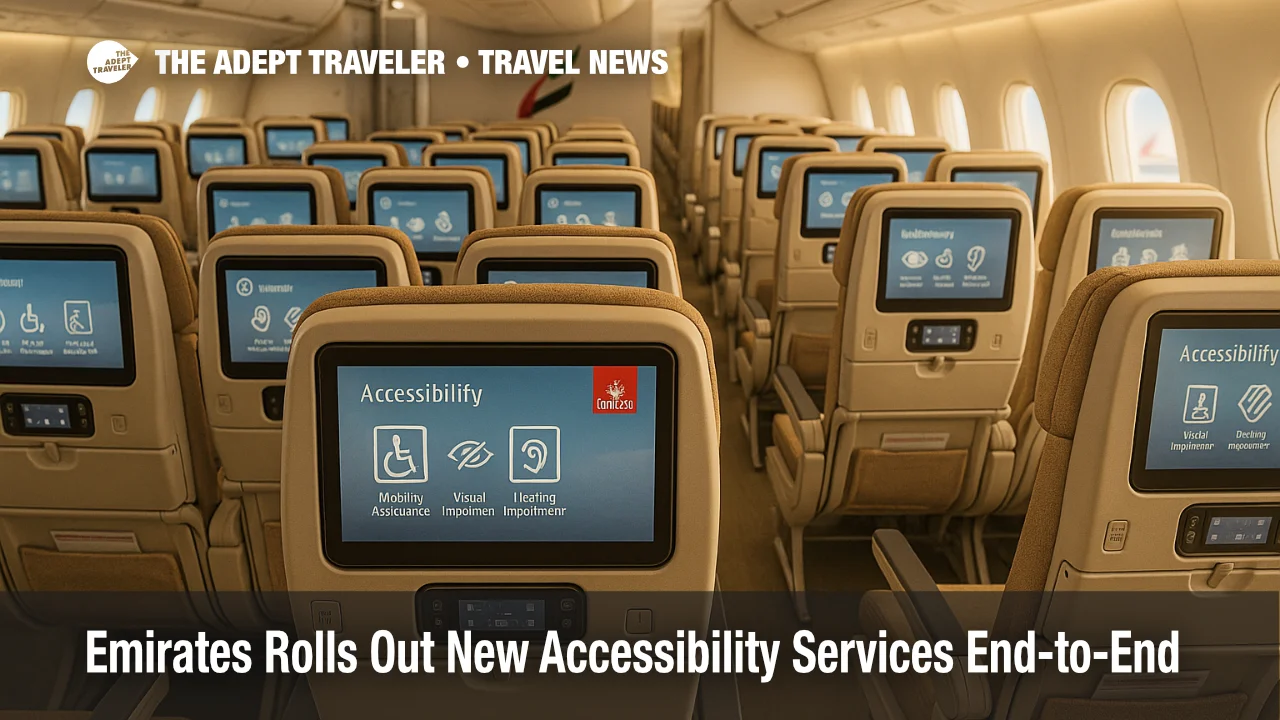Emirates rolls out new accessibility services end-to-end

Travelers who require accessibility accommodations could see smoother trips on Emirates this fall. The Dubai-based carrier unveiled a suite of services at the AccessAbilities Expo on October 7, 2025, spanning booking, airport, and in-flight touchpoints. Highlights include an "Accessible & Inclusive Travel Hub," sensory kits for neurodivergent customers starting November 1, expanded closed-caption and audio-description libraries, an audio-cue interface debuting on A350-900 aircraft, and upgraded self-service kiosks at Dubai International Airport (DXB).
Key points
- Why it matters: More consistent, predictable support across booking, airport, and onboard phases.
- Travel impact: Sensory kits, IFE upgrades, and kiosk enhancements reduce friction for many disabilities.
- What's next: A fleet of 10 wheelchair-accessible chauffeur vehicles targeted for early 2026.
- A350-900 interface adds audio-cue navigation for customers with visual impairments.
- New business-class "mattress hood" improves security and comfort for limited-mobility travelers.
Snapshot
Emirates' new "Accessible & Inclusive Travel Hub" centralizes guidance by disability type and by journey stage, with sections like "Before your flight," "Departure from Dubai," "Onboard your flight," "Connecting in Dubai," and "Arriving in Dubai." On November 1, the airline begins distributing sensory products onboard, including a tactile aircraft stress reliever, two fidget cubes, and an aircraft rubber popper, offered to neurodiverse passengers, travelers who are struggling, and nervous flyers when appropriate. Business-class cabins gain a fitted "mattress hood," designed to remain secured during taxi, takeoff, and landing. Across cabins, the ice system features more than 600 closed-caption films, about 200 with audio description, and a new audio-cue interface rolling out on Airbus A350-900 jets.
Background
The launch builds on Emirates' multi-year accessibility roadmap, including its move in 2025 to become the world's first Autism Certified Airline under IBCCES standards. The airline and Dubai Airports have piloted "travel rehearsals" for families with neurodivergent children, and introduced sensory guidance to set expectations at each step. At the airport, Emirates has progressively updated self-service infrastructure at Terminal 3. The latest iteration adds text-to-speech, braille and tactile features, adjustable screens, and a headphone jack for customers with sight impairments. Emirates also previewed a prototype wheelchair-accessible Chauffeur Drive vehicle. The carrier says a 10-vehicle fleet is planned by early 2026 for first and business-class customers at DXB, with expansion to additional airports under review.
Latest developments
How Emirates' accessibility services work from booking to boarding
On the website, the "Accessible & Inclusive Travel Hub" organizes information by disability type, including Mobility Assistance, Visual Impairment, Hearing Impairment, and Hidden Disabilities, as well as by journey phase. Customers can request assistance, review wheelchair policies, and access an autism-friendly travel guide. At the airport, upgraded kiosks in Terminal 3 add screen-reader support and tactile controls, plus headphone jacks to improve privacy for audio prompts. From November 1, sensory kits will be offered onboard to help manage overstimulation. Business-class seats receive the fitted "mattress hood" to reduce mid-flight repositioning for travelers with severe mobility disabilities. Onboard entertainment now includes extensive closed-caption and audio-description catalogs, and an audio-cue interface on the new A350-900 supports independent navigation for customers with visual impairments.
Analysis
Emirates' announcement stands out for its end-to-end framing. Airlines often debut a single tactic, such as adding closed captions or an assistance page. Here, the carrier is linking pre-trip planning, airport self-service, cabin hardware, and media accessibility into a coherent journey. Two pieces matter most for real-world impact. First, the sensory kits. Because overstimulation can spike at unpredictable moments, the availability of tactile tools at the seat is a practical win for neurodivergent travelers and anxious flyers. Second, audio-cue navigation on the A350-900 moves beyond content accessibility to interface accessibility, enabling more independent use of the ice system. The upgraded kiosks at Dubai International Airport are also notable, but benefits will scale as similar features roll out beyond DXB. Finally, the planned wheelchair-accessible Chauffeur Drive vehicles add critical first- and last-mile reliability. Execution will hinge on staff training, equipment availability, and consistent global procedures, but the roadmap meaningfully advances inclusive travel.
Final thoughts
For travelers who need predictable support, Emirates' phased upgrades offer practical, measurable improvements across the booking path, airport touchpoints, and the cabin. If delivered consistently, the combination of sensory kits, interface upgrades, and accessible ground services should reduce anxiety and effort at each step. The next threshold is scale: extending kiosk features to more airports, expanding audio-cue interfaces fleetwide, and accelerating the accessible Chauffeur Drive rollout. For now, the airline's plan represents tangible progress toward inclusive air travel, and a clear benchmark among Emirates accessibility services.
Sources
- Emirates empowers customers with accessibility requirements, Dubai Media Office
- Emirates showcases its innovations at AccessAbilities Expo, WAM
- Size and substance: Behind the scenes of the world's largest media library in the sky, Emirates media centre
- Emirates set to become the world's first Autism Certified Airline, Emirates media centre
- AccessAbilities Expo, official site
- Emirates' latest services and enhancements for customers with accessibility requirements, Zawya press note
